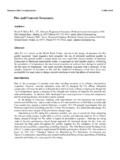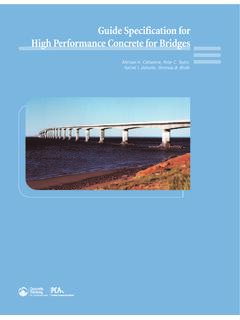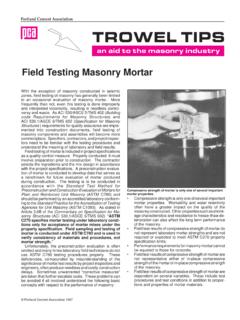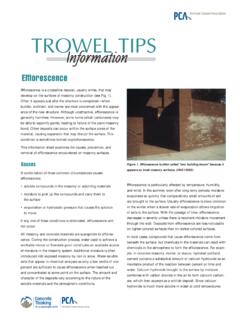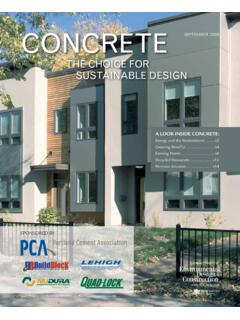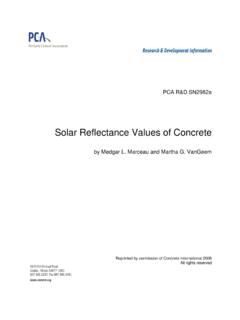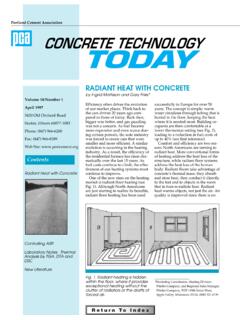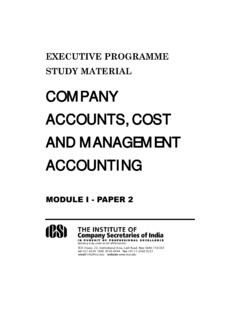Transcription of Guide to FULL-DEPTH RECLAMATION (FDR)
1 Reprinted January 2019[March 2017] Guide toFULL- depth RECLAMATION (FDR) with CementInjection of waterMilling drumDistressed asphaltUnderlying base materialDeep recycled layerOperating direction1. Report Government Accession Recipient s Catalog Title and SubtitleGuide to FULL-DEPTH RECLAMATION (FDR) with Cement5. Report Date[March 2017] January 20196. Performing Organization Code7. Author(s)Garret D. Reeder, Dale S. Harrington, Michael E. Ayers, Wayne Adaska8. Performing Organization Report Performing Organization Name and AddressNational Concrete Pavement Technology CenterInstitute for Transportation, Iowa State University2711 South Loop Drive, Suite 4700 Ames, IA 50010-866410. Work Unit No. (TRAIS)11. Contract or Grant Sponsoring Organization Name and AddressPortland Cement Association5420 Old Orchard RoadSkokie, IL 60077-108313.
2 Type of Report and Period CoveredGuide/Manual14. Sponsoring Agency Code15. Supplementary NotesReprinted with minor amendments16. AbstractAs the nation s infrastructure ages, agencies at all levels are tasked with maintaining and rehabilitating their infrastructure. Sustainable engineering technologies in pavement rehabilitation, such as FULL-DEPTH RECLAMATION (FDR), could be the answer for agencies in their quest to provide taxpayers with high-quality infrastructure while being good stewards of public funds. FULL-DEPTH RECLAMATION of asphalt pavement is a rehabilitation method that involves recycling an existing asphalt pavement and its underlying layer(s) into a new base layer. The FDR process begins with using a road reclaimer to pulverize an existing asphalt pavement and a portion of the underlying base, subbase, and/or subgrade.
3 Usually the pulverized material is uniformly blended with an additional stabilizing material such as portland cement to provide an upgraded, homogeneous material. Finally, the stabilized material is compacted in place with rollers. The result is a stiff, stabilized base that is ready for a new rigid or flexible surface course. This Guide introduces the FDR with cement process and discusses issues related to project selection, design, construction, and testing/quality Key Wordsasphalt pavement recycling FULL-DEPTH RECLAMATION with cement pavement base pavement rehabilitation 18. Distribution Statement19. Security Classification (of this report) Security Classification (of this page) No. of Pages10222. PriceNAForm DOT F (8-72) Reproduction of completed page authorizedTechnical Report Documentation PageAuthorsGarret D.
4 Reeder, , Snyder & Associates, S. Harrington, , Snyder & Associates, E. Ayers, PhD, Global Pavement Consultants, Inc. Wayne Adaska, , Portland Cement AssociationProgram managerGabriel A. Nelson, , Snyder & Associates, staffMarcia Brink, Managing EditorStephen Post, Graphic Designer and Layout EditorGUIDE TO FULL-DEPTH RECLAMATION (FDR) WITH CEMENT[March 2017]January 2019viGuide to FULL-DEPTH RECLAMATION with CementAbout This GuideThis Guide to FULL-DEPTH RECLAMATION (FDR) with Cement is a product of the National Concrete Pavement Technology Center (CP Tech Center) at Iowa State University s Institute for Transportation, with fund-ing from the Portland Cement Association. The Guide provides a concise discussion of all aspects of selecting, designing, and constructing a reclaimed, cement- stabilized asphalt base in preparation for a new pavement surface layer.
5 Photo CreditsUnless otherwise credited in the text, the photographs and illustrations in this Guide were provided by, and used with the permission of, the following individuals and organizations:Brigham Young UniversityFigure Estrada, Pavement Recycling SystemsFigures , Asphalt Paving IndustryFigure Concrete Pavement Technology CenterFigures , , , , , , , , , Cement AssociationFigures , , , , , , , , , , , , , , , , , , , , , , , , , , , , , , , , , , , , , , , , and Associates, , , , , , , , , Stokes, The Miller Group, , , , , , , , , More InformationFor technical assistance regarding cement-based concrete paving, contact the Portland Cement Association or the CP Tech Center:Wayne Adaska Director, Pavements and Geotechnical MarketsPortland Cement Association5420 Old Orchard , IL 60077847-972-9056, Taylor, DirectorMarcia Brink, Managing EditorNational Concrete Pavement Technology CenterInstitute for Transportation, Iowa State University2711 S.
6 Loop Drive, Suite 4700 Ames, IA 50010-8664515-294-9480, Iowa State University nor the Portland Cement Association nor this document s authors, editors, design-ers, illustrators, distributors, or technical advisors make any representations or warranties, expressed or implied, as to the accuracy of information herein and disclaim liability for any State University does not discriminate on the basis of race, color, age, ethnicity, religion, national origin, sexual orientation, gender identity, genetic information, sex, marital status, disability, or status as a veteran. Inquiries regarding non-discrimination policies may be directed to the Office of Equal Opportunity, Iowa State University, 3410 Beardshear Hall, 515 Morrill road , Ames, IA 50011; tel 515-294-7612, hotline 515-294-1222, email to FULL-DEPTH RECLAMATION with CementAcknowledgmentsNote that much of the information in this document is based on two excellent resources: the Portland Cement Association s Guide to FULL-DEPTH RECLAMATION (FDR) with Cement (Luhr et al.)
7 2014) and the Asphalt Recycling and Reclaiming Association s Basic Asphalt Recycling Manual (ARRA 2015). The CP Tech Center gratefully acknowledges the support of the Portland Cement Association (PCA) in the devel-opment and production of this Guide . In addition, the center and authors are grateful to the knowledgeable and experienced professionals, public and private, who served on the technical advisory committee for this project. While the authors generated the overall content, it was the committee s careful reviews of drafts and thoughtful suggestions that make this Guide a useful resource. Thank you to the committee members:Wayne Adaska, PCAStan Bland, PCA Southeast RegionDavid Cannon, PCA Northeast RegionMarco Estrada, Pavement Recycling SystemsDavid Faust, Blount Construction Company, Hourani, Summit CompaniesAndy Johnson, PCA Southeast RegionJamie Johnson, PCA Rocky Mountain RegionJim Render, EssrocDavid Rettner, American Engineering Testing, Redinger, Resource International, Ryan, Mt.
8 Carmel Stabilization Group, Schellhammer, Midstate RECLAMATION and Trucking, Singel, Cement Council of TexasKimbel Stokes, The Miller Group, Stowell, Slurry Pavers, Syed, Soil and Land Use Technology, Wykoff, California Nevada Cement AssociationviiiGuide to FULL-DEPTH RECLAMATION with CementChapter 1 Introduction 1 What is FDR? 2 Benefits of FDR 2 Why Add a Stabilizing Agent? 4 Types of FDR Stabilization 5 When is FDR Applicable? 6 Are There Limitations to Using FDR? 6 How is FDR Constructed? 7 Sustainability of FDR 8 Common FDR Projects 9 Primary State and Rural Highways 9 Arterials 10 Local Streets 10 Parking Lots 11 Airports 11 Life Expectancy of FDR 11 Chapter 2 Properties and Materials 13 Density 14 Strength 14 Flexural Strength 15 Unconfined Compressive Strength ..15 Modulus of Elasticity 16 Resilient Modulus 16 Modulus of Subgrade Reaction 16 Permeability 17 Freeze/Thaw Durability 17 Poorly Reacting Soils 19 Chapter 3 Project Evaluation 21 Determining When FDR is Appropriate 22 Problems with Subbase/Subgrade 22 Damaged Pavement Beyond Resurfacing 22 FULL-DEPTH Patching Required (>15 20% Surface) 22 Pavement Inadequate for Future Traffic 23 Corrections to Crown/Profile (Roadway Geometry) 24 Desktop Study 25 Record Drawings Existing Pavement Structure 25 Photo Surveys 25 Pavement Management Report/System 25 Field Review 27 Drainage 27 depth Checks of Existing Utilities 27 Visual Assessment 28 Fatigue (Alligator)
9 Cracking 28 Block Cracking 29 Potholes 30 Rutting 30 Shoving 31 Additional Information 31 Sampling of Pavement System 32 Final Determination 32 Economic Assessment 32 Scheduling 33 Chapter 4 Structural Design 35 Background 36 Design Considerations 37 Site-Related Input Values 37 Traffic Characterization 37 Support Conditions 37 Existing Pavement Structure 38 Design-Related Input Values 38 Design life 38 Reliability 38 FDR-Related Properties 38 Additional Design-Related Inputs 39 Pavement Design 39 Flexible Pavement Design 39 Rigid Pavement Design 42 1993 AASHTO Design Guide 42 ContentsixGuide to FULL-DEPTH RECLAMATION with Cement StreetPave Design Procedure 44 Alternate Pavement Design Assuming Bonding Between the Slab and FDR Layer 44 Joint Spacing 47 Chapter 5 Field Sampling and Mix Design 49 Obtain Field Samples 50 Core or Auger Sampling 52 Block Samples 53 Frequency of Sampling 53 Highways and airports 53 Arterial and industrial streets 53 Residential streets 53 Subgrade/Subbase Foundation 53 Determine Gradation of Sample 54 Atterberg Limits Test 55 AASHTO Soil Classification 56 Determine Chemical Compatibility of Existing Material 56 Sulfate Content 56pH of Existing Material 57 Organic Content 57 Selecting Cement Contents for Testing 57 Optimum Moisture Content and Maximum Dry Density 58 Unconfined Compressive Strength Tests 59 Freeze-Thaw Durability Tests 60 Mix Design Report 61 Chapter 6 Construction 63 Equipment 64 Reclaimer 64 Motor Grader 65 Cement Spreader 65 Water Truck 66 Compaction Equipment 66 Detailed Construction Process 66 Pulverizing 66 Grading 69 Cement Placement 70
10 Dry Cement Placement 70 Slurry Cement Placement 70 Mixing 70 Compaction and Final Grading 71 Curing 72 Concrete Overlays 73 Unbonded PCC Overlay 73 Bonded PCC Overlay 73 Environmental Considerations 74 Temperature 74 Rain 74 Wind 74 Opening to Traffic 74 Chapter 7 Field Inspection and Testing 75 Inspector s Checklists 76 Preconstruction Checklist 76 Equipment Checklist 76 Construction Checklist 77 Quality Control 78 Pulverization 79 Cement Application 79 Moisture Content 79 Uniform Mixing and depth 80 Density Tests 81 Coring of Completed Work 81 Testing Frequency 82 Early Opening to Traffic 82 Chapter 8 Long-Term Performance 83 Visual Surveys 84 Long-Term Strength 84 Durability 85 References 87xGuide to FULL-DEPTH RECLAMATION with CementFiguresChapter road reclaimer performing FDR of an asphalt roadway Unstabilized asphalt base results in more con-centrated stress on the subgrade than FDR with cement FDR with cement base reduces fatigue cracking compared to an unstabilized base FDR with cement reduces the permeability of the base layer compared to a base of RAP or other unstabilized granular material Asphalt pavement with patching Asphalt pavement with extensive alligator cracking Utilities like this manhole may need to be lowered beneath the proposed FDR depth before construction Schematic of a roadway reclaimer during FDR process Application of dry cement powder to pulverized mix Application of cement slurry to pulverized mix FULL-DEPTH RECLAMATION train with water truck (left) and reclaimer Final compaction of FDR base with a tamping roller (right)
